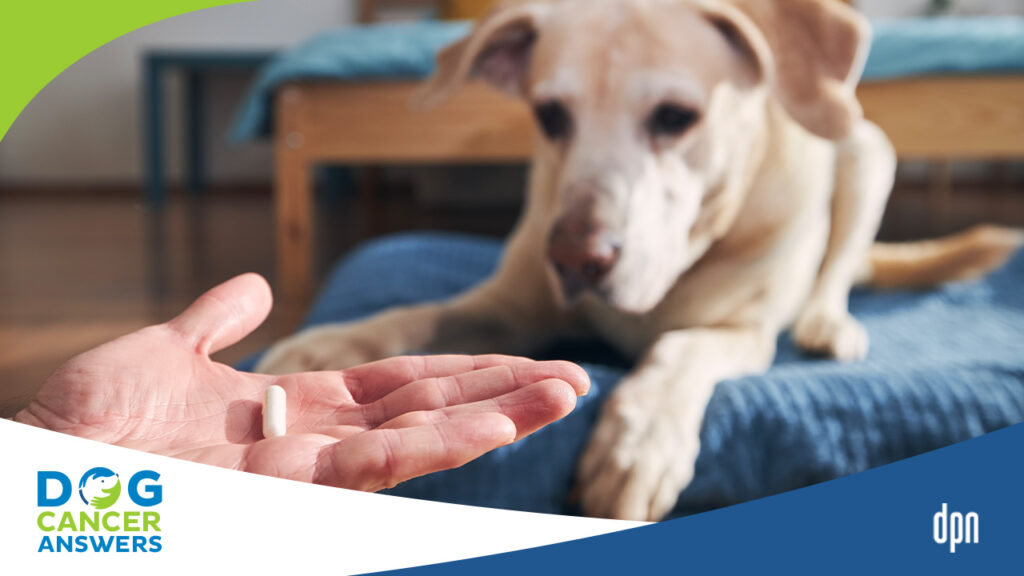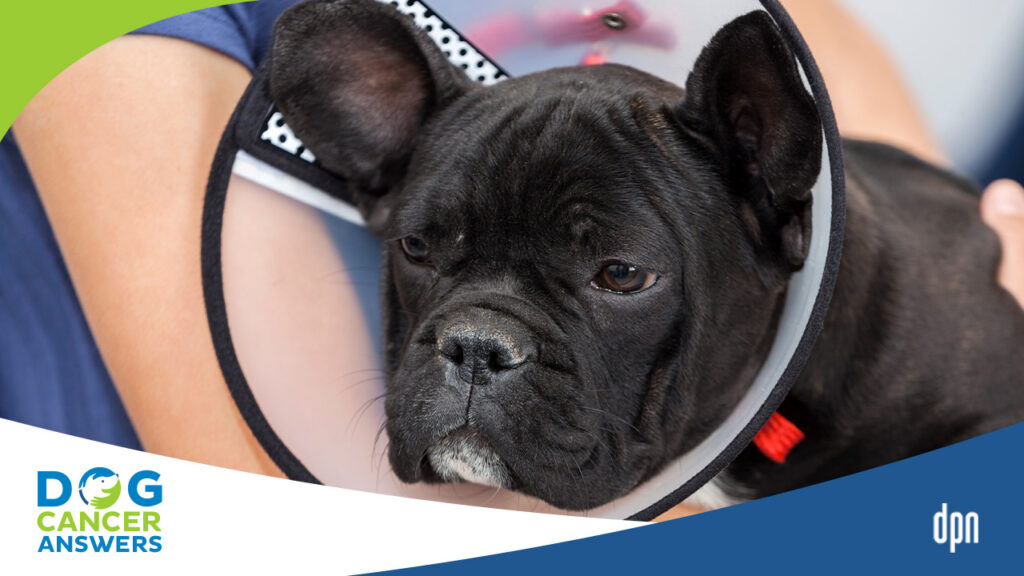EPISODE 192 | RELEASED November 14, 2022
How Does PEMF Therapy Help Dogs with Cancer? | Dr. Erica Ancier
PEMF therapy is safe, easy to use at home, provides relief for pain and inflammation, and may even have some anticancer effects.
SHOW NOTES
Veterinarian Erica Ancier explains how pulsed electromagnetic field therapy (PEMF) can fit into your dog’s cancer treatment plan (or other health needs!). This modality is safe for most dogs, and has no side effects – perfect for combining with other therapies to achieve optimal pain control.
She also discusses specific products and some of the pros and cons of each one. Listen in to learn how PEMF therapy can help your dog.
Links Mentioned in Today’s Show:
Assisi Animal Health/Zomedica https://assisianimalhealth.com/
Respond Systems https://respondsystems.com/pemf/
BEMER https://life.bemergroup.com/pemf-pulse-electro-magnetic-field/
[00:00:00] >> Dr. Erica Ancier: Overall, it’s a nice, safe modality that can help a lot with just quality of life. Helping with pain, inflammation relief, and just help them feel better. So yes, we don’t know the exact effects of it on cancer, although it seems overall safe. But you know, the time that we have with them is precious and I always wanna emphasize the quality of life.
[00:00:22] >> Announcer: Welcome to Dog Cancer Answers, where we help you help your dog with cancer.
[00:00:28] >> Molly Jacobson: Hello, friend. Today on Dog Cancer Answers, we’re joined by Dr. Erica Ancier, a veterinarian who focuses on rehabilitation therapies to help our pets move more easily and feel less pain. Dr. Ancier has joined us before on Dog Cancer Answers, she talked to us before about rehab after amputation. But today we are looking into something a little different: Pulsed Electro-Magnetic Field Therapy, or PEMF.
PEMF is a tool that can help provide pain relief for our dogs undergoing cancer treatment. And it’s also showing some anti-cancer effects in its own right. Dr. Ancier, it’s nice to meet you.
[00:01:11] >> Dr. Erica Ancier: Nice to meet you.
[00:01:12] >> Molly Jacobson: So we are talking today about pulsed electro-magnetic field therapy, and you’ve been using this for pain relief, but also for cancer, is that right?
[00:01:24] >> Dr. Erica Ancier: Not primarily for cancer. You know, I’m a rehab veterinarian and so I mostly am dealing with like a lot of arthritis and pain and inflammation, but it is generally considered a safe modality to use in patients that have cancer, whereas some other things you have to be a little bit more careful with. But you know, there’s still some conflicting ideas about all that I, I definitely wanna talk about more.
[00:01:48] >> Molly Jacobson: Yeah. So let’s start there. Why is it considered safe for cancer, what could it do for cancer, and how does it work? What are we actually talking about?
[00:02:00] >> Dr. Erica Ancier: Yeah. How does it work? So let’s actually start there. So.
[00:02:03] >> Molly Jacobson: Okay. Yeah.
[00:02:03] >> Dr. Erica Ancier: PEMF, uh, you know, we’re talking about pulsed electromagnetic field therapy, so it’s using inductive coils to deliver electric and magnetic fields like, so energy, into tissues.
[00:02:15] >> Molly Jacobson: So those inductive coils, you mean there’s literally electricity running through coils and it like, looks like, like a, what does it look like? Explain it to people.
[00:02:24] >> Dr. Erica Ancier: There’s all different ways it can look. There are always some kind of coil. So some of the systems have just one, you know, kind of one loop, Assisi Loop in particular, that you’ll hold over a particular area and that covers a certain field. Others, it’s coils that are within a mat that the animal will lie on.
[00:02:41] >> Molly Jacobson: Okay.
[00:02:42] >> Dr. Erica Ancier: Or I even have the system that you use on horses, and it’s a blanket that you put on them over their neck and, and different coils all throughout the blanket that are connected, delivering it kind of through their whole body.
[00:02:53] >> Molly Jacobson: I see. So when it’s a mat, it might look like a, like one of those electric blankets, for example, but it’s not just putting heat out, it’s doing something else.
[00:03:03] >> Dr. Erica Ancier: Yeah, no heat. It’s almost undiscernible to a lot of people and animals. If you hold a magnet next to one of these devices, you will feel a little tick, tick, tick. You’ll feel a little pulse, a little movement in your hand.
[00:03:17] >> Molly Jacobson: Oh.
[00:03:17] >> Dr. Erica Ancier: That’s actually how you test that the coils are working, so sometimes you know, if something gets off, a cord gets loose, they can become disconnected. And so some of the devices, they come with a, um, magnet to test it. Some people only can feel it with that. I personally, and I think some animals, can feel a little more. Like if I’m lying on it, I feel a little bit of a wave through my body. It feels kind of calming and soothing. Some animals, you put it on, you turn it on and they get off. They feel a sensation for sure. Others kind of fall asleep.
[00:03:49] >> Molly Jacobson: Right. So it’s using electricity to pulse in a magnetic field somehow. Can you just explain a little bit about what a magnetic field, why would we even want to use this to treat anything or to generate it in any way for any reason?
[00:04:05] >> Dr. Erica Ancier: Yeah, so it’s basically stimulating the body’s tissues to then, you know, promote different things. So similar to, you know how laser therapy is using the light and it improves blood flow and it’s anti-inflammatory, and it helps with pain, actually by almost the same mechanisms, but just a different type of energy source.
[00:04:27] >> Molly Jacobson: Okay.
[00:04:27] >> Dr. Erica Ancier: It’s stimulating cells. It’s increasing nitric oxide, so that simulates the release of some cytokines that help with inflammation, help with pain. So just like when you take NSAIDs or anti-inflammatories, those inhibit, you know, COX-2 and prostaglandins, it can have those effects. It can also improve circulation and increase growth factors.
[00:04:52] >> Molly Jacobson: Oh.
[00:04:52] >> Dr. Erica Ancier: So part of the concern is that if you’re increasing growth factors, are you promoting angiogenesis and basically the growth of new blood vessels and could that, you know, help the cancer and not the patient?
[00:05:07] >> Molly Jacobson: Right. In general, in cancer tumors we do not want to encourage them to grow new blood vessels. We want to discourage that behavior on the part of the cancer cells.
[00:05:16] >> Dr. Erica Ancier: Exactly. So that’s where the controversy lies, you know. Looking into it a little bit, some will say, Well, it really kind of works more on healthy cells and vasculature, and when cancer makes blood vessels, it makes these torturous kinda weird vessels and they don’t kind of play by the same rules, so to speak. And so it, there has been no evidence of it actually increasing cancer ever. And it has been studied to some extent, different ways.
[00:05:44] >> Molly Jacobson: Okay.
[00:05:45] >> Dr. Erica Ancier: So no evidence of any adverse effects, ever.
[00:05:48] >> Molly Jacobson: Okay.
[00:05:49] >> Dr. Erica Ancier: The contraindications are really active blood flow, so you don’t want to, you know, increase hemorrhage, uh, by stimulating blood flow in the area.
[00:06:00] >> Molly Jacobson: ‘Cause it increases blood flow. So if blood is already flowing in a way we don’t want, you don’t want more of that. Okay.
[00:06:05] >> Dr. Erica Ancier: Yeah. So avoiding active hemorrhage. Pacemakers, it would definitely interfere with a pacemaker. And believe it or not, I do have some patients with pacemakers, some dogs. And then over cartilage. So if it’s a growing animal that has open growth plate, it could actually, you know, prematurely promote the closure of those.
[00:06:24] >> Molly Jacobson: I see. So it’s a real thing, magnetic therapy. I mean, it’s used in humans, right? This is not just a veterinary application, like this is being used in humans routinely for years, is my understanding.
[00:06:38] >> Dr. Erica Ancier: Yeah, it’s been, I mean, therapeutically used for over a century. And it is, you know, FDA approved for a number of things, you know, non-healing fractures, post-op pain and inflammation, chronic pain, arthritis, and there is no like, warning on that for humans as far as cancer.
[00:07:00] >> Molly Jacobson: Okay.
[00:07:00] >> Dr. Erica Ancier: So there’s no limitations on the human side. Really just based on the theory of, well, if it can promote blood flow that maybe it would be potentially concerning for cancer, that’s the only reason why there’s any kind of controversy with it. That said, you know, as I speak to you right now, my dog who has active liver cancer is lying on a PEMF mat with it on.
[00:07:23] >> Molly Jacobson: This is not a concern for you as someone who uses this. You’ve never seen anything and there’s nothing in the literature that would say that it’s bad for dogs with cancer, you said earlier.
[00:07:36] >> Dr. Erica Ancier: Yeah. So, you know, different companies, um, there’s a few main companies that make these things for animals and they have different stances on it. So Assisi Loop is one of the main ones. They’ve done a nice study on postoperative pain after back surgery, IVDD surgery, in dogs showing that they, you know, got off pain meds sooner and they actually had better proprioception or awareness of their feet sooner, which is wonderful.
It’s safe for cancer. Avoid in active hemorrhage, as I mentioned. So they said maybe take caution using this over, for example, the spleen of a dog that has hemangiosarcoma.
[00:08:14] >> Molly Jacobson: Okay. I mean that’s a cancer of the blood vessels, of the lining of the blood vessels. So we really wouldn’t wanna stimulate the blood vessels probably in any like really aggressive way in general in hemangiosarcoma. It seems that’s reasonable.
[00:08:28] >> Dr. Erica Ancier: Yeah. Those tend to bleed and that’s how it can spread and it can also cause a lot of discomfort. And so you wouldn’t wanna promote that. They even say, you know in a palliative situation, if it’s just helping them feel better, you know, go for it. I also talked to Respond Systems. They don’t have a statement kind of online, I just chatted with them ’cause I like that company a lot, and you know, they still basically say to not use it over cancer because of that, you know-
[00:08:56] >> Molly Jacobson: Theoretical concern. Yeah. Well, theoretical concerns, you know, are tricky in vet medicine, I think, because you can’t get the consent of the dog to take a chance, right? So people are always more conservative when it comes to their own dogs. But if someone wanted to try this with their dog, how would they find it?
[00:09:19] >> Dr. Erica Ancier: So most of them you can actually order directly from the company. You can also get it through your veterinarian. They can be prescribed and often approved, like if you have pet insurance. So will cover it-
[00:09:31] >> Molly Jacobson: Oh, wow.
[00:09:31] >> Dr. Erica Ancier: -which is really helpful. So there’s Assisi Loop, I mentioned. They have both the handheld loops that you can put over a specific area – that’s another way, by the way, if you have any kind of concern, you’re not sure if you wanna use it on your dog that has cancer, but you know that they have elbow arthritis in a completely separate area, you could just place it on their elbow, nowhere near their cancer, and be assured it’s not gonna have systemic effects.
[00:09:55] >> Molly Jacobson: Okay.
[00:09:55] >> Dr. Erica Ancier: So there’s that company. There’s Respond Systems, which I mentioned makes the mats and the bed. They do not have a handheld device. They also make a system for horses. And then BEMER is another company that also makes kind of mats and horse blankets and things like that. I don’t believe they have a handheld device, although I was not able to get ahold of somebody for, you know, their point of view on this one.
[00:10:16] >> Molly Jacobson: Okay. So the idea is that you buy the device, hopefully get it covered by your pet insurance – because hopefully all of us will be getting pet insurance for our young dogs from now on because we all need to know that things are covered – and if you have it, how often do you use it, and can you use it without a veterinarian showing you how to use it or is it pretty intuitive to use? How does that work?
[00:10:43] >> Dr. Erica Ancier: They are pretty intuitive. And it depends, I guess, what you’re treating. So some of the devices actually have the ability to choose different settings.
So Respond Systems, you can do lower pulses per second, which is indicated more for acute inflammation, higher pulses per second, more for chronic inflammation. And so you can change certain parameters. And they all have their separate, you know, their, their carrier frequency, their intensity, all these parameters within them, and that’s where the tricky part lies with kind of knowing protocols and with the studies that have been done in cancer.
But I say for kind of, you know, if they’re really painful and you’re doing it more, you know, for that, or they just had, you know, I think it’s, it’s great if they just had a mass removal, for example, and in fact it’s been done in a study in human breast cancer after it was removed and that improved postoperative pain and had no negative effects on their cancer. So early on, something like that, three times a day would be great.
[00:11:46] >> Molly Jacobson: Okay.
[00:11:46] >> Dr. Erica Ancier: They go anywhere from 15 minutes to an hour, depending on the device. Otherwise you could use it kind of as needed, you know, my dog’s a little stiff, I’m gonna use it now. Maybe I reach for that rather than something that might be a little bit more harmful to their liver or kidneys, or you could do it regularly.
[00:12:03] >> Molly Jacobson: Ah. So if your dog is on NSAIDs for some sort of chronic pain condition, would this be something that possibly you could use and maybe start to reduce the use of, of other medications that control pain?
[00:12:17] >> Dr. Erica Ancier: Yes. I’m a big fan of just multimodal pain management. And anything that doesn’t really have negative effects, such as PEMF, you know, I always gravitate towards. So I will often combine it with other modalities, you know, laser, acupuncture, massage, and, you know, medications. And so sometimes this does provide good relief and you can reduce other medications that might have more side effects.
[00:12:44] >> Molly Jacobson: Wow, that’s great. So when used for cancer, how is it used for cancer?
[00:12:50] >> Dr. Erica Ancier: So, in the studies, they’ve looked at a few different things. They’ve looked at it directly on cells, and there was even some studies showing that when they did it directly on cells, that it actually inhibited growth of cancer cells but had no, you know, negative effects on healthy cells. That was a study they did on human breast cancer cells. But they’ve also done things on, you know, adenocarcinoma, so colon cells, showing that actually there was better uptake of the chemotherapy agents-
[00:13:25] >> Molly Jacobson: Oh.
[00:13:26] >> Dr. Erica Ancier: -when combining it with PEMF.
[00:13:28] >> Molly Jacobson: Really?
[00:13:29] >> Dr. Erica Ancier: Yes, ’cause it helps promote, you know, circulation.
[00:13:32] >> Molly Jacobson: Okay. So when they’re applying it in these studies, are they putting it directly on the breast tissue or on the abdomen? It’s not an internal wand or something that they’re trying to get inside of you, it’s all applied on the outside of the skin, correct?
[00:13:47] >> Dr. Erica Ancier: Yeah, so those studies in particular, those were actually just done, you know, Petri dish style on a cell line.
[00:13:53] >> Molly Jacobson: Okay.
[00:13:53] >> Dr. Erica Ancier: There’s been other studies where they did it, you know, on mice for example that had melanoma and you know, same thing. They combined it with chemotherapy and they saw that had better effects than the chemotherapy alone and better effects than the PEMF alone. So combining it with chemotherapy is actually, I think, a really good use for it. It’s just gonna help it distribute better into the body.
And if you ever have to do a dose reduction with chemotherapy, that might, you know, help get better effects from it and, and potentially avoid some of the negative effects just by reducing inflammation and, you know, helping with pain.
[00:14:29] >> Molly Jacobson: So it can aid the chemotherapy while also reducing the side effects associated with chemotherapy.
[00:14:36] >> Dr. Erica Ancier: Absolutely. There was another study where they looked at timing of it as well, and it did seem to be kind of important that it was done around the same time as the chemotherapy.
[00:14:45] >> Molly Jacobson: So if you had a device like this and your dog’s on a protocol, they come home from their chemo appointment, maybe you go ahead and use the Loop or the mat, have them lie down on it for 15 minutes, and it might aid that session that just ended, and creating more of an effect than – oncologists might be happy the next time they do a checkup to say, Oh look, we did even better than before, maybe.
[00:15:12] >> Dr. Erica Ancier: Yeah, potentially it could help that drug or – even, you know, if you’re doing more of a holistic approach, if you’re doing different herbs, you know, whatever you are doing, it’s gonna help it circulate better in the body. And so I think that, you know, without anything else – I mean there is that one study where they showed on a cell line yes it seemed to somehow negatively impact the growth of those abnormal cells – but I think its better indication is with other therapies.
[00:15:43] >> Molly Jacobson: Okay, so just so I make sure that I understand what you just said, there’s a study that says PEMF alone reduced tumor size, it seemed to actually directly address the tumor. But there’s more and better evidence for it helping chemo and other therapeutics do their job. Am I understanding correctly?
[00:16:05] >> Dr. Erica Ancier: Yes. And the evidence is, it’s still scattered. Like I tried to look at all these studies to see, okay, what would be the best, you know, duration, intensity-
[00:16:16] >> Molly Jacobson: Right.
[00:16:17] >> Dr. Erica Ancier: -carrier frequency, all of this, right?
[00:16:20] >> Molly Jacobson: Yeah.
[00:16:21] >> Dr. Erica Ancier: And every study did different parameters. So you know, I can’t say, Oh, this device, or this setting on this device would be a better option, at this point in time. And that, you know why, you know a company like Respond Systems, they don’t wanna comment yet. They just feel like the evidence isn’t there yet. And I agree. That said, you know, we’re all just doing the best we can to help these animals. And I think that they generally seem really safe.
They can certainly help with pain and inflammation and are well proven for that, help with healing if they have a mass removal, and seem like they would promote circulation. There are several studies showing that there is better uptake of chemotherapy agents into cells with PEMF therapy. So I think that’s a, you know, great indication, although still not yet proven per se.
[00:17:14] >> Molly Jacobson: Well, that is fascinating. We’re going to take a short break, but when we come back, I want to ask you about settings for doing PEMF therapy at home.
And we’re back with Dr. Erica Ancier.
So when you get these devices, can you adjust them so that they use, like you’re talking about frequency, intensity, you know, I’m thinking, Oh, are there a lot of knobs? Like, am I gonna be able to figure out how to use it once I get it? Like, what are the settings? Do you have recommendations or do they give you a cheat sheet, do they come with good instructions? Like what actually happens when you get this in your home, how do you use it?
[00:17:53] >> Dr. Erica Ancier: Yeah. Most of them do come with some information and are not that adjustable. So, uh, the Assisi Loop, it’s basically you click a button and it goes for 15 minutes and then it turns itself off.
[00:18:05] >> Molly Jacobson: Okay.
[00:18:06] >> Dr. Erica Ancier: And that’s it. There’s no adjusting it, that’s what you get. The Respond System ones, I know you can choose different pulses per second, although there’s the, they have a particular carrier frequency that’s not adjustable, a particular intensity. And so you can’t adjust any of that, just up or down with the pulses per second. And BEMER I’m not quite sure about. There are some really strong PEMF devices, there are these big coils they use on horses and in people. There’s MagnaWave and there’s EquiPulse, and, those, you actually, if you hold the coil over tissue, you actually see all the tissue pulse.
[00:18:40] >> Molly Jacobson: What?
[00:18:41] >> Dr. Erica Ancier: Yeah. It’s a whole different thing. That you definitely feel. It can actually be painful, especially if you have a sore, you know, I put it over my shoulder, my shoulder was sore. It hurt a lot. But that can help with pain.
[00:18:52] >> Molly Jacobson: Did you feel better afterward though?
[00:18:54] >> Dr. Erica Ancier: Not in that one treatment personally, but others will say they do. You know what works for one doesn’t always work for others. Those haven’t been as well studied, the really high intensity ones, and I know you can adjust the intensity on those, but I think those might be a little bit much for cancer.
And those are big systems. Those are not something you’re gonna get at home. You might get someone to come and do a treatment, but those are you know, $30,000 plus systems.
[00:19:18] >> Molly Jacobson: Oh, okay.
[00:19:19] >> Dr. Erica Ancier: Yeah.
[00:19:19] >> Molly Jacobson: Insurance is not gonna cover that.
[00:19:21] >> Dr. Erica Ancier: Absolutely not.
[00:19:22] >> Molly Jacobson: Right.
[00:19:22] >> Dr. Erica Ancier: No. So the other ones are pretty intuitive, pretty, pretty easy. You know, as far as the parameters for this when it comes to dealing with cancer, if you’re combining with chemotherapy, other things, I don’t think they’re gonna have specific guidelines on that.
[00:19:33] >> Molly Jacobson: Okay.
[00:19:33] >> Dr. Erica Ancier: But they will have guidelines for kind of pain management, you know, how long to use, some of them have, you know, certain settings you’ll use, you know, for arthritis versus other things, and some of it, you know, see how your dog does. Do they do better at a lower pulses per second? Do they do better at a higher pulses per second?
[00:19:51] >> Molly Jacobson: Okay. So you can see like if your dog gets up and leaves, that’s probably not an ideal setting, so you might wanna try something different. See what they seem to relax into?
[00:20:01] >> Dr. Erica Ancier: Yeah, they do tend to relax by the way, it is calming. And actually Assisi Loop makes a whole separate device, very similar, called Calmer Canine, and they did a study on separation anxiety. And they wear the loop over their head like a little halo.
[00:20:15] >> Molly Jacobson: No.
[00:20:15] >> Dr. Erica Ancier: It’s kind of a little attachment for it. It’s cute. Very cute. And they actually had improved separation anxiety. They had videos with people leaving their homes and the dogs at first were kind of panicking and getting into stuff, and later after using the device kind of regularly, not when they leave, just other times of day, they kind of relax and just slept.
[00:20:36] >> Molly Jacobson: Well that’s an interesting use for this device. I mean, separation anxiety is a gigantic problem for so many dogs.
[00:20:44] >> Dr. Erica Ancier: Absolutely. And I think a lot of also dogs when they have cancer and they get a little bit more needy and you’re around them more, they get a little more dependent on you. Having something like that to calm them down… also as a rehab vet, I instruct people all the time to do massage and stretching on their animals. Some melt into it, some, you know, want nothing to do with it.
And I do find that they relax better if you get them on this mat and turn it on, and then you do the massage and stretching on there. It has that calming effect and you’re kind of getting two treatments at once, which is nice.
[00:21:19] >> Molly Jacobson: Well, that’s really interesting. So how long do these devices last? Like I buy it and then I can use it for how long? And can I use it with more than one dog and can I use it on myself?
[00:21:30] >> Dr. Erica Ancier: Yes. Yes, yes, and yes. Uh, the Assisi Loop device, the Loop that they make lasts you know, 150 treatments they guarantee it for, it might last more. That one they have specific things like if you use it, don’t use it again for two more hours. So yes, you could use it on another animal, you could use it on yourself, but wait a period of time, otherwise it just depletes the battery. And those are essentially disposable.
[00:21:57] >> Molly Jacobson: I see. So the Assisi Loop is sort of a disposable, like it doesn’t have, it’s not built to last you years and years and years. You’re not gonna be using it five years, 10 years from now.
[00:22:07] >> Dr. Erica Ancier: Exactly. That one you know, is the most affordable because it’s just one little loop, it covers one area. So if I have a dog with arthritis everywhere, that’s not my favorite thing ’cause you’re gonna be sitting there all day moving it from spot to spot. Um.
[00:22:20] >> Molly Jacobson: And waiting for it to recharge for two hours in between.
[00:22:23] >> Dr. Erica Ancier: Yeah. And the dog has to sit still with that loop on it. They do make, you know, little jackets and stuff to try to hold it in place, but that’s one, you know, factor why I don’t always use those. The Assisi Loop also makes a Loop Lounge, which is basically like a little carrier that you can put a small dog or a cat in. Or they make mats as well. Those are rechargeable.
[00:22:45] >> Molly Jacobson: Okay.
[00:22:45] >> Dr. Erica Ancier: Kind of like a cell phone battery, they should last, you know, similarly to that. And the same thing with the Respond Systems, and I believe the BEMER as well. Those are all rechargeable units, so you know, you charge it up, you can use it a variety of times, I think for mine it’s like eight sessions, and then you have to recharge it. I’ve had to replace the battery on my own unit once in the few years that I’ve had it, and it was like $80. So it’s not bad, you know.
[00:23:11] >> Molly Jacobson: Oh, that’s not bad.
[00:23:12] >> Dr. Erica Ancier: Comparatively.
[00:23:13] >> Molly Jacobson: Okay.
[00:23:13] >> Dr. Erica Ancier: Yeah, so those are the questions I asked before kind of getting a bigger device. I had a Loop for a while and I wanted to invest in a mat, and I was like, Okay, so how long do they last, you know, what do you need to replace, how expensive is it to replace it?
[00:23:25] >> Molly Jacobson: Yeah. So if you get a mat, how big is that mat?
[00:23:29] >> Dr. Erica Ancier: It’s a variety of sizes. So they have ones that are really small for small animals.
[00:23:33] >> Molly Jacobson: Okay.
[00:23:33] >> Dr. Erica Ancier: A lot of people do end up getting the kinda extra large, the big one because they wanna lie on it themselves.
[00:23:40] >> Molly Jacobson: Yeah.
[00:23:41] >> Dr. Erica Ancier: Yeah.
[00:23:41] >> Molly Jacobson: Well, it sounds really great. I mean, I have some chronic pain that I would like to lay on a mat and have taken care of in 15 minutes, experience some relief without having to do anything pharmaceutical.
For sure.
[00:23:54] >> Dr. Erica Ancier: Yeah. And you can lie on there with your animal. That’s not gonna interfere with them having treatment, you can lie on there with your animal and both get the effects. Every device has a particular field, so you know what it’s gonna cover kind of above the device or on the sides of the Loop that they can provide you so you know which areas are covered, which are not.
[00:24:13] >> Molly Jacobson: Very interesting. So for our listeners, they don’t necessarily need to go to their vet and say, I wanna get PEMF for my dog. They could go directly to the companies that make these devices, buy one, and use it pretty safely at home. Is that true, or do you think that they should really be talking to their vet before they use the device?
[00:24:37] >> Dr. Erica Ancier: I always think it’s a good thing to consult with your vet, because they’re gonna know the best, you know, what else is going on with your, your animals’ health, you know, if there’s any other concerns that they have, you know, such as a pacemaker. Anything like that. But overall, pretty safe. You know, avoid in young growing animals, avoid in pregnant animals for that same reason.
Avoid if you’re concerned about active hemorrhage and with a, with a pacemaker, but otherwise quite safe. So you could, you know, get it directly from the company, but I always think it’s nice to consult with your veterinarian about it. Depending on the background of your vet, some might be more well versed in it than others. Holistic and rehab vets tend to know PEMF really well. Conventional vets might be less informed or not really have much of an opinion on it. Some of them may. You never know.
[00:25:28] >> Molly Jacobson: Wonderful. Is there anything else that you think our listeners need to know about PEMF?
[00:25:34] >> Dr. Erica Ancier: I think it’s just overall, it’s a nice, safe modality that can help a lot with quality of life. So, you know, helping with pain, inflammation relief can, you know, just help them feel better. So yes, we don’t know the exact effects of it on cancer, although it seems overall safe. But the time that we have with them is precious and I always wanna emphasize the quality of life and not, you know, always quantity.
I don’t know its effects as far as the quantity, if it’s gonna slow down your dog’s cancer, what it’s gonna change with that. But it can certainly help a lot of these animals feel better. And I think that that’s really just so valuable, the quality of time that we have with them, you know, it’s never long enough.
[00:26:15] >> Molly Jacobson: I completely agree. What I love about PEMF is you can do it at home. I just love the fact that you can do it at home on your dog’s schedule without having to go to a clinic and sort of get exposed to all of the clinical stress that a lot of dogs feel. That is something you can do at home for your dog, under veterinary supervision of course. So I’m excited about this and to share it with our listeners.
[00:26:39] >> Dr. Erica Ancier: Yeah, that, that’s honestly one of the best things about it, is that it’s relatively affordable and you can do it at home. So when I’m spacing out treatments like acupuncture or laser, you know, for pain in the clinic, I always recommend PEMF. I, I very frequently recommend it for a home, you know, modality that they can make a big difference with pain and inflammation, kinda similar to some of the effects we do in the clinic, they’re all a little bit different, but, um, you see some really good benefits with your animals. I know I, I do with my own as well.
[00:27:10] >> Molly Jacobson: That’s wonderful. Well, thank you. I hope you’ll come back and join us again, Dr. Ancier.
[00:27:16] >> Dr. Erica Ancier: I would love to. Caring for our older patient is truly a passion of mine that, you know, I, I deal with a lot of different injuries in some young dogs and all different stuff in rehab, but caring for our geriatric dogs and keeping them active and happy and minimizing their pain is truly my passion.
[00:27:35] >> Molly Jacobson: Their bodies are old and slowing down, but they hold all the love that we’ve given and shared with them over the years, right? They’re so precious.
[00:27:43] >> Dr. Erica Ancier: They definitely get better with age.
[00:27:46] >> Molly Jacobson: So true. Well, thanks again.
[00:27:49] >> Dr. Erica Ancier: Thank you. Take care.
[00:27:50] >> Molly Jacobson: We initially decided to look into PEMF for dogs with cancer because our producer, Kate Basedow, has used it on her dogs for pain relief. I invited Kate to join me to talk about her own experiences. So Kate Basedow, thank you for joining me to talk about your experience with PEMF, both in the clinic and hopefully at home, ’cause I know you use these products.
[00:28:14] >> Kate Basedow: Yeah. Thanks for asking me to come on again. So my first experience with PEMF stuff was when I was down at the University of Tennessee for labs for their rehab certification program, and got to see it in action on a couple different patients. And then I got an Assisi Loop for my dog Queezle ’cause she had arthritis and she had had, at that point, two knee surgeries. So I was like, you know, we’ll give this a try.
[00:28:45] >> Molly Jacobson: Sure.
[00:28:46] >> Kate Basedow: And so if she had days when she was a little sore, I would do it on her. And definitely she tolerated it well, no problems. She didn’t have any real response dramatically to the treatments using the Loop. A couple years later, I got one of the beds from Respond Systems, which Dr. Ancier was talking about, to have something to kind of treat the whole dog at once instead of having to jump from knee to knee.
And then when Queezle got arthritis in her carpuses up front, or her wrist, I was like, All right, we can just kill all those birds with one stone, do one treatment for the whole dog if she’s laying on this bed. And it was really interesting because she had a spot where she would always be on her dog bed, and so I put her favorite dog bed on top of the PEMF bed.
[00:29:35] >> Molly Jacobson: Oh, so you can put a dog bed on top of the device or the mat, and it still works.
[00:29:40] >> Kate Basedow: Yeah.
[00:29:41] >> Molly Jacobson: Ah.
[00:29:41] >> Kate Basedow: So there’s the mat inside with the coils, and then the bed has a thin foam layer, and then there’s a dog bed kind of water resistant covering on the outside that is washable, which is good because you know, things happen with dogs.
[00:29:58] >> Molly Jacobson: Things happen, right.
[00:29:59] >> Kate Basedow: But you can put another thin bed on top for extra protection if you want to.
[00:30:05] >> Molly Jacobson: Oh.
[00:30:05] >> Kate Basedow: I had reached out to the company ’cause the bed she liked the best was like two to three inches thick and I was like, I’m not sure if that’s too thick. And they said that width could get her far enough from the coils, but you can feel on the bed which side has the coils and which side doesn’t. So for her, I flipped it so that the foam was on the bottom and the coils were on the top, just to have it a little closer to her body-
[00:30:30] >> Molly Jacobson: Okay.
[00:30:30] >> Kate Basedow: -on the bed. But so with her, if I turned it on when she was just awake and sitting on her bed, she would leave. She’s like, This feels-
[00:30:39] >> Molly Jacobson: Oh she felt it.
[00:30:40] >> Kate Basedow: Yeah. She was like, This feels weird, and I don’t know what it is, but I’m out, and leave. But, if I waited until she was actually asleep on it before I turned it on-
[00:30:50] >> Molly Jacobson: Uh-huh.
[00:30:50] >> Kate Basedow: -she wouldn’t wake up, and she would actually stretch out.
[00:30:53] >> Molly Jacobson: Oh.
[00:30:54] >> Kate Basedow: Whereas most of the time she would sleep kind of curled. But when I had the bed running when she was sleeping, she would totally stretch out and relax. So I know it felt good, even though she didn’t wanna admit it.
[00:31:09] >> Molly Jacobson: Right, right. You were tricking her into feeling good.
[00:31:12] >> Kate Basedow: Yeah.
[00:31:12] >> Molly Jacobson: So there must just be something about it that startled her and made her think, too weird, I’m outta here. Not necessarily that it felt bad.
[00:31:21] >> Kate Basedow: Yeah.
[00:31:21] >> Molly Jacobson: Because obviously it doesn’t feel bad or else she would wake up.
[00:31:24] >> Kate Basedow: Exactly.
[00:31:25] >> Molly Jacobson: Okay.
[00:31:26] >> Kate Basedow: And she was just also the type of dog where things had to somewhat be her idea. And so she’s like, Eh, I didn’t ask for this, so I’ll be in the other room when you need me. But her daughter, Lynah, would sometimes go on the bed when I had turned it on and Queezle had left, and she loved it. And she had never really used that bed before, ’cause that was Queezle’s bed, her spot-
[00:31:54] >> Molly Jacobson: Okay.
[00:31:54] >> Kate Basedow: -in my office. And she started trying to steal that bed more often after doing a couple of treatments.
[00:32:01] >> Molly Jacobson: Oh. So you believe, for sure, that these devices were helping your dogs, that they at least liked using them. Did you see anything like easier movements, or less pain, longer walks, anything like that going on?
[00:32:17] >> Kate Basedow: For Queezle I didn’t see a huge difference, largely because the issues I was dealing with with her were chronic things where I was just trying to maintain a pretty good level of pain control and mobility. She wasn’t really on pain medications regularly until the last year or so of her life. Usually I only gave her pain meds if we had a day where I knew she was gonna be extra active. But for Lynah, she had a neck injury in, um, let’s see, October, 2017, she ran into a metal pole wanting a ball.
I hadn’t even thrown the ball yet, but she was very excited, took off running and smacked right into it. And as a result of that, had a bad neck injury, and she’s got bridging in her spine in her neck which resulted in horrible, horrible pain. She was screaming, extremely uncomfortable and upset.
[00:33:13] >> Molly Jacobson: Oh.
[00:33:14] >> Kate Basedow: And as well as medications, she was on muscle relaxers and a brief course of pred to get the inflammation down fast. I was also using the Assisi Loop on her neck, which was perfect ’cause I could just put it over her head, she wore it like a collar or a necklace and could move around and do what she wanted.
[00:33:32] >> Molly Jacobson: Oh, I see.
[00:33:32] >> Kate Basedow: And it definitely made a difference for her. And I have used that – she’s only had one flare up in the years since then, and I’ve used it for that. I also use it kind of as a preventive measure for her if I know we’re gonna be doing something active. Like she still does some agility trials, I do the Loop around her neck both before the trial and then at the end of the day afterward. And that has really helped to keep her stable and pain-free.
[00:34:02] >> Molly Jacobson: That’s wonderful. So when you use it, you said when she had a flare up, did you also use NSAIDs or any other pain medication at that time, or did the Loop seem to really do the job?
[00:34:14] >> Kate Basedow: I did the Loop the night where I first noticed that things were getting weird. We did get pain medications the next day to totally tamp it down ’cause after – the first time was horrific. She would scream if she moved her head at all, and it took us like two days to figure out what was going on.
[00:34:32] >> Molly Jacobson: Oh.
[00:34:32] >> Kate Basedow: So I wasn’t sleeping, she wasn’t sleeping, it was awful. So the minute she got twingy the second time, I was like, You’re going on all the drugs cause we’re not doing this again.
[00:34:42] >> Molly Jacobson: Right.
[00:34:43] >> Kate Basedow: But we only had to do the short course of medications to get the immediate acute inflammation down and then managed the rest using the Loop.
[00:34:52] >> Molly Jacobson: Oh, that’s wonderful.
[00:34:53] >> Kate Basedow: Yeah.
[00:34:54] >> Molly Jacobson: Because those NSAIDs are, you know, wonderful when they’re needed for what they’re needed for, but they do take their toll, especially when you have to use them a lot.
[00:35:05] >> Kate Basedow: Yeah. And especially with her, she was only six or seven. So it’s like, expecting her to live another seven years or whatever, I don’t want her to have to be on NSAIDs every day the whole rest of her life if I can avoid it. Obviously, first priority is pain control.
[00:35:23] >> Molly Jacobson: Right.
[00:35:23] >> Kate Basedow: But I also wanna preserve organ function for as long as possible and not put any stress we don’t have to.
[00:35:29] >> Molly Jacobson: Right. So that’s really interesting. So you really feel like PEMF is helping your dogs in these specific ways?
[00:35:37] >> Kate Basedow: Yeah. I like it.
[00:35:38] >> Molly Jacobson: Great. Is there anything else that people need to consider, do you think, when they’re looking at this as a therapy for their dog?
[00:35:47] >> Kate Basedow: If you’re thinking about trying it, contact local veterinary clinics, especially if they do have a rehab division. And some of the places have an in-house Loop that you could do, make an appointment and do a treatment with your dog to see how they tolerate it, get a feel for how it works, something like that. Some clinics also will rent out devices. That’s a little less common, but you never know.
[00:36:14] >> Molly Jacobson: Right.
[00:36:15] >> Kate Basedow: You might also, depending on your relationship with your vet and your clinic, talk them into buying a device for the hospital and renting it out. Be like, Hey, this could be a good business decision for you and I’ll be your Guinea pig with my dog.
[00:36:30] >> Molly Jacobson: That’s a good idea.
[00:36:31] >> Kate Basedow: Yep. Kind of a win-win for everyone.
[00:36:33] >> Molly Jacobson: Uh-huh. And also for other dogs in that practice who maybe wouldn’t have access to that technology unless you introduced it to your veterinarian.
[00:36:42] >> Kate Basedow: Exactly.
[00:36:42] >> Molly Jacobson: Or the, the concept. Yeah. That’s what happens so often, right? Especially in today’s age, is that people introduce things to the medical professionals and then they figure out whether it’s worth trying and, and that’s how, that’s how we are getting new applications for all of these things. That’s why people are helping dogs in the future.
[00:37:03] >> Kate Basedow: Yeah, and like some hospitals keep the Assisi Loop or the different brands of mats in house and just put them on every single patient post-op after surgery to get that first healing treatment to help with the incision healing right away and get down the inflammation from the surgery. So there’s lots of different ways that you could use it for a lot of different health problems.
[00:37:29] >> Molly Jacobson: Yeah. And healing after surgery would be actually pretty big-
[00:37:33] >> Kate Basedow: Yeah.
[00:37:34] >> Molly Jacobson: -for a lot of people listening, right?
[00:37:36] >> Kate Basedow: And especially ’cause with cancer, a lot of times you’ve got compromised tissues and wounds that might have issues healing. So anything that can kind of help it along is a plus.
[00:37:47] >> Molly Jacobson: Right. Okay. So Kate, explain to me how these devices work from your perspective.
[00:37:54] >> Kate Basedow: They were both really user friendly coming into it kind of blind. The Assisi Loop, especially, is super simple. There’s one button. A green light comes on to tell you that it’s doing its thing, and then when the green light stops blinking, it’s done.
So you can’t really mess it up. The only thing is if you turn it on when you don’t mean to turn it on, then it’s going to do its 15 minute treatment, you can’t stop it once it’s going. But the world doesn’t end.
[00:38:24] >> Molly Jacobson: Okay. And then that does not have a replaceable or rechargeable battery, right?
[00:38:28] >> Kate Basedow: Correct.
[00:38:29] >> Molly Jacobson: So that 15 minutes, you wanna use it.
[00:38:30] >> Kate Basedow: Yeah, ideally.
[00:38:31] >> Molly Jacobson: Yeah.
[00:38:32] >> Kate Basedow: Yep. So if you accidentally turn on, you know-
[00:38:34] >> Molly Jacobson: Treat something.
[00:38:34] >> Kate Basedow: Put it on whatever part of your dog hurts, put it on your sore ankle, I’ve done that.
[00:38:39] >> Molly Jacobson: Sure.
[00:38:40] >> Kate Basedow: Yep. But it’s very easy. Just press the on button, put it around the area that you want treated, let it do its thing. The Respond Systems bed has a cube with buttons on it and it comes with instructions, and that cube contains the battery, which you can also plug in to recharge, and it plugs into the bed when you’re actually using it. That one, you’ve got a little more options for settings and you can stop it. And it’s treatments, you can set it for either half an hour or a full hour. And you can adjust how fast the pulses are going.
[00:39:20] >> Molly Jacobson: Okay.
[00:39:20] >> Kate Basedow: So that one was a little more of a learning curve, but still pretty simple ’cause you could just charge up the battery, plug it in, press power, and let it do whatever it chose to do.
[00:39:31] >> Molly Jacobson: Okay. Very cool. So overall, thumbs up from you on PEMF devices for dogs.
[00:39:38] >> Kate Basedow: Yes. Yep.
[00:39:39] >> Molly Jacobson: Thanks, Kate. This is really interesting. I’m still kind of mystified by exactly what’s going on in the pulsed electromagnetic field therapy devices and exactly how they work, but that’s true for just about every medical device that we encounter in the real world. Thanks for joining us today, Kate.
[00:40:00] >> Kate Basedow: Always a pleasure, Molly.
[00:40:02] >> Molly Jacobson: And thank you listener. Here at Dog Cancer Answers, we just love treatment options that come with no side effects, right? That’s a rare thing, and PEMF is one of those gems. It may or may not help with your dog’s actual cancer, but it certainly is an excellent tool for speeding up healing after surgery or providing pain relief based on what we know today.
Check out the show notes for links to the different companies and products that were mentioned today. And also be sure to subscribe to our newsletter. Dog Cancer News comes out three times a week with information to help you and your dog have an easier time on your cancer journey.
I’m Molly Jacobson, and from all of us here at Dog Podcast Network, I’d like to wish you and your dog a very warm Aloha.
[00:40:57] >> Announcer: Thank you for listening to Dog Cancer Answers. If you’d like to connect, please visit our website at dogcanceranswers.com, or call our Listener Line at (808) 868-3200. And here’s a friendly reminder that you probably already know: this podcast is provided for informational and educational purposes only. It’s not meant to take the place of the advice you receive from your dog’s veterinarian.
Only veterinarians who examine your dog can give you veterinary advice or diagnose your dog’s medical condition. Your reliance on the information you hear on this podcast is solely at your own risk. If your dog has a specific health problem, contact your veterinarian. Also, please keep in mind that veterinary information can change rapidly, therefore, some information may be out of date.
Dog Cancer Answers is a presentation of Maui Media in association with Dog Podcast Network.
Hosted By
SUBSCRIBE ON YOUR FAVORITE PLATFORM
Topics
Editor's Picks
CATEGORY









